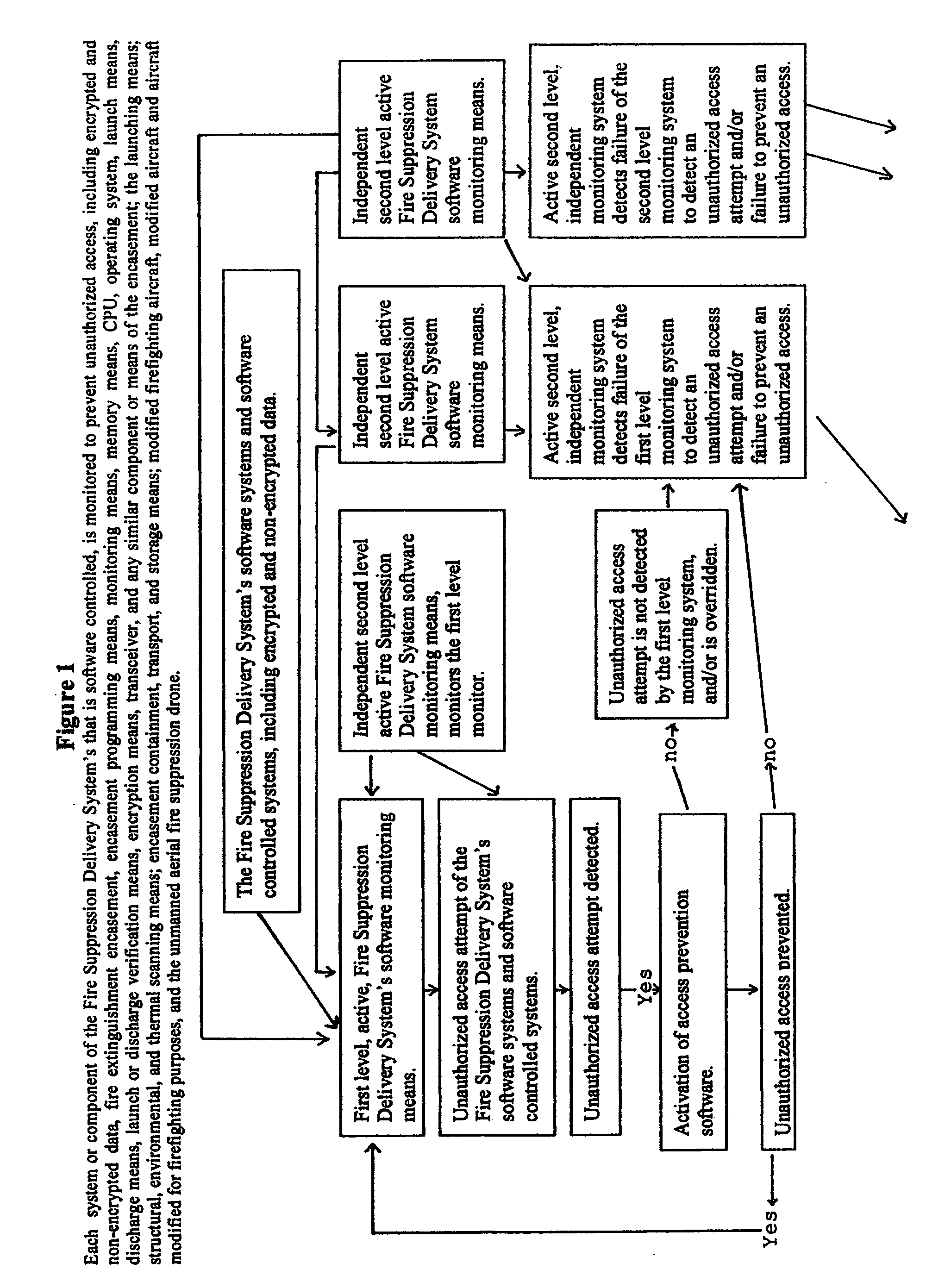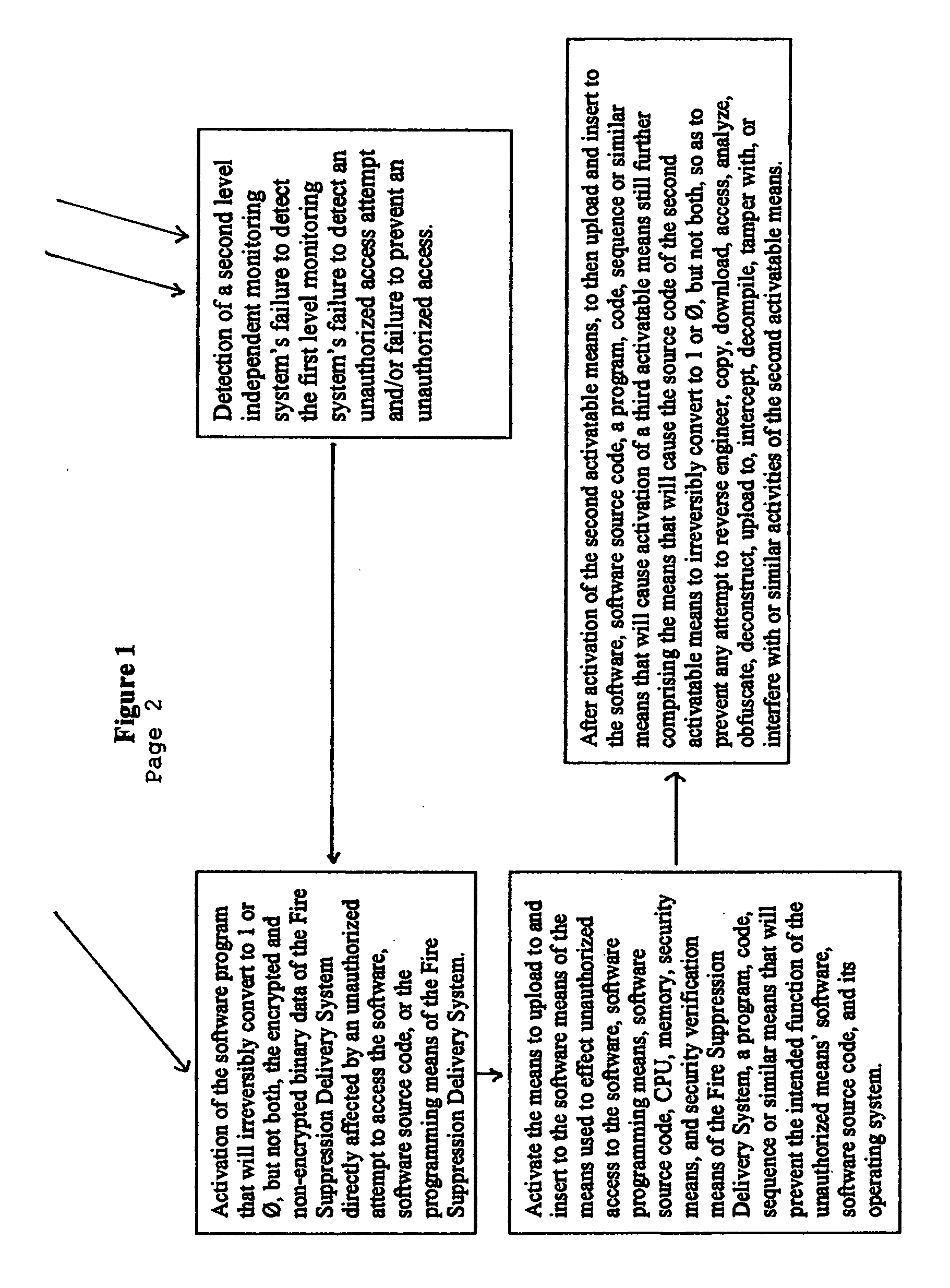[0029]To overcome this concern, additional software or program safety features are envisioned, including software codes to prevent
reverse engineering,
copying, downloading, decompiling, tampering with or similar activities. As an additional measure to safeguard the System, where unauthorized access results in overriding the primary anti-
reverse engineering code and the System's next
security level, then multiple, embedded, independent, security measures are proposed. The multiple, independent, embedded, security measures are redundant programs designed to prevent unauthorized overriding of the entire
system by an unauthorized entity bypassing one or two levels of the anti-reverse
engineering access means. When triggered, the multiple, embedded, security measures will convert all encrypted data to an irreversible, single negative or positive code format; systematically set in motion destruction of the software and
memory systems; upload to the unauthorized user's computer and electronic means used for such access codes that will ultimately
shut down and render the latter useless; and, prevent decompilation of the software program that caused it to
shut down.
[0030]A second objective of this invention is to develop a Fire Nemesis System™'s binary Smart Fire Extinguishment Encasement that will deliver and effectively deploy a foam
firefighting agent.
[0031]A third objective of this invention is to improve the maneuverability of the Fire Nemesis System™ Smart Fire Extinguishment Encasement, by incorporating one or more airbrakes to increase drag. In a preferred embodiment, when the control means of the airbrake
system that is linked to the encasement's trajectory, search, and
discharge controls is activated to deploy one or more of the airbrakes to the external surface, the trajectory's
turning radius and speed can be reduced.
[0032]A fourth objective of this invention is to enhance operations of the Fire Nemesis System™ Aerial Fire Suppression
Drone and other aircraft employed for
firefighting purposes, by including high quality insulation, to its exterior and interior surfaces, to provide protection against
exposure to the
extreme heat environment of a fire; enclosed rotary,
turbofan engines for hovering and closer maneuverability within the fire zone, with shrouds or ducts for protection against debris common to fire zones; the installation of 180° vertical high-speed fire extinguishment jets; the employment of mid air refueling and fire extinguishment replenishment means, and docking collars to facilitate attachment to a host aircraft for transport and deployment purposes, refueling and replenishment; exterior
fuselage and interior chamber strengthening to withstand the
impact of debris common to (environmental) fire zones. By incorporating an alternative power generation means for operation in
low oxygen level environments the aircraft will not be compromised by airborne fire related particles, the
fouling of air intakes, or
oxygen depletion created by the fire, and / or the effective use of fire extinguishments; exhaust vectoring to increase thrust and improve maneuverability;
fuselage retraction of the
tail rudder assembly and the horizontal flight wing, along with the extension of multiple shorter stabilizing wings will increase aircraft stability for in-fire zone operations. By vertically
ringing the
fuselage's exterior with (
high pressure) fire extinguishment or encasement ejectors, incorporating fire extinguishment containment means with a
load capacity up to 5,000+psi or 10,000+psi, and equipped with a vibration means to prevent clogging and freezing within the extinguishment holding means and connecting lines, pumps, and ejection ports, such will enhance deployment of (
powder, granular or similar) fire extinguishments to the environment. It is further the objective of this invention to develop a modified Fire Nemesis System™ Aerial Fire Suppression
Drone or similar aircraft primarily for but not limited to vertical
flight operations within a structural fire zone, as well as an environmental fire zone.
[0033]A fifth objective of this invention is to develop a smart building
fire detection and scanning
system that can be directly linked to the scanning capabilities discussed in the Fire Nemesis System™: that will operate from within the target structure and the fire itself. By integrating
real time scan data achieved by the smart building scanning means with the Second and
Third Generation systems of the Fire Nemesis System™, firefighters can look at the fire from a view within the fire zone itself, with an enhanced ability to program the smart encasement for fire extinguishment of the area.
 Login to View More
Login to View More  Login to View More
Login to View More 


